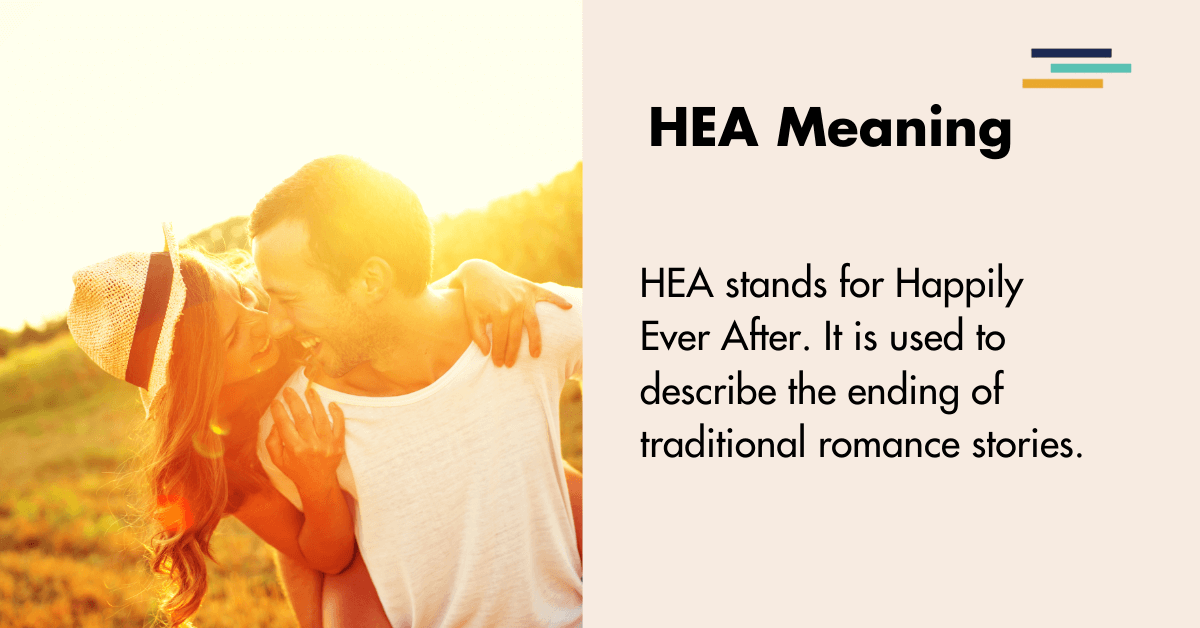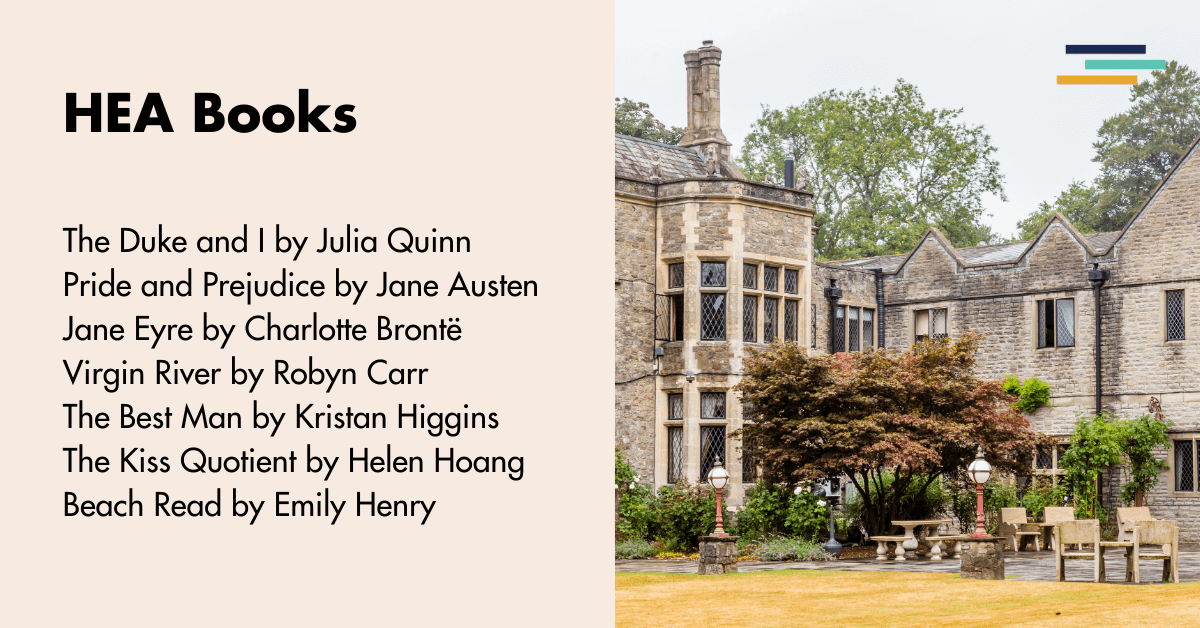
Romance novels are consistently the best-selling genre in fiction. According to Publishers’ Weekly, sales of romance print books increased 52% in 2022 from the previous year.
In addition to the many screen adaptations of romance novels, there are many reasons for their popularity, including the numerous tropes and sub-genres available. But perhaps the biggest reason is the way most romance novels conclude: the HEA.
What Does HEA Stand For?
HEA stands for Happily Ever After. The term has served as the ending to many fairy tales and romantic stories and is believed to have originated centuries ago in an Italian story.
Entitled The Decameron (Italian title: Il Decamerone), the story, written by Giovanni Boccaccio in the 14th century and translated into English by John Payne in 1702, features a character named Paganino of Monaco. He marries the widow Bartolomea and “as they were well acquainted, so they lived very lovingly, and happily, ever after.”
I hate mentioning that Paganino stole the widow away from her husband and they married upon the death of said husband. (It sort of takes the romance out of it, doesn’t it?) But happily, it ends on an upbeat note.
HEA Book Meaning
For many years, the term “happily ever after” described the idyllic life that awaited the love interests at the end of fairy tales, like Cinderella, Sleeping Beauty, and Snow White.
Romantic novelists often employed the phrase in tandem with a marriage proposal to signal the blissful end of the story, giving a generic hint as to the couple’s problem-free future as they rode off into the sunset. This gave the impression they’d enjoy perfect health, avoid troubles, and remain as much in love as the day they’d first declared their undying love for each other.
The happily ever after ending has evolved since the publication of traditional fairy tales, but romance fans remain dedicated to the genre because of the promise of that happy ending.
No matter what trials and tribulations the couple face during the novel, readers cling to the guarantee that the characters will end up together in a satisfying way at the end of the story. It’s a safety net that romance readers count on, a promise that allows them to escape into the world and identify with the characters, stick with them through despairing lows, and cry tears of joy as they declare their love and eternal devotion.

What Does HFN Mean in Books?
A happily ever after ending once meant marriage and babies, but along with the times, that has evolved.
Now, a happy ending in a romance may involve an HFN, a Happy For Now resolution. It resolves the story with a positive outcome that is more hopeful than eternal. Often this reflects a more realistic conclusion to the romance, and sometimes it provides a hook into the next book in a series.
No matter which option you choose, it’s important to note that romance readers expect a happy ending, whether it’s an HEA or an HFN. Without a happy ending, it doesn’t fit into the romance genre. It may be a great love story, but without that happy ending, it betrays the readers.
Consider the classic film Casablanca. While Rick and Ilsa declare they still love each other, the ending (SPOILER ALERT!) shows them moving on separately. Rick decides they should consider more than their feelings for each other and take an active role in fighting the enemy in World War II. As a result, he urges Ilsa to stay with her husband, a freedom fighter, while Rick joins the resistance.
It’s bittersweet, and definitely not the happily ever after most romance lovers demand. It is a beautiful love story, but it is not a romance.
Examples of HEA in Books
With varying levels of swoon-worthiness, these books have the Happily Ever After ending romance readers crave:
The Duke and I by Julia Quinn
This book, the first in the Bridgerton series, features the story of a lady and a duke. In order to fend off unwanted suitors and matchmakers, Daphne and Simon agree to a fake courtship in early 19th century England.
Their arrangement leads to a deep attraction, and a scandalous kiss forces them into marriage. Conflicting desires and deceptions temporarily jeopardize their happy ending, but their love for each other triumphs in the end.
Pride and Prejudice by Jane Austen
Most romance fans know the classic story about Elizabeth Bennet and Mr. Fitzwilliam Darcy set in early 19th century England. The pair initially dislike each other, each showing their own prejudices through a series of misunderstandings.
As their paths continue to cross, revelations lead them to better understand each other and ultimately fall in love. It’s an essential read for romance lovers.
The Wedding Date by Jasmine Guillory
When Drew gets trapped in an elevator, it results in an unexpected meeting with Alexa, who agrees to pose as his date for the upcoming wedding of his ex.
But the pretend date leads to a genuine kiss, which sends sparks flying and the relationship becoming anything but fake. They face obstacles like geographic separation and insecurities, but true love wins in the end.
Jane Eyre by Charlotte Brontë
Jane Eyre suffers a harsh childhood at the hands of her cruel aunt. She survives and goes on to become a governess, eventually meeting the brooding Mr. Rochester.
Despite their differences, they fall in love, and he proposes. But devastating obstacles prevent the marriage and Jane leaves. After turning down a cousin’s marriage proposal, Jane realizes she still loves Rochester. Despite more hardships, they reunite and marry, finding happiness and love.
Virgin River by Robyn Carr
The first book in Carr’s popular Virgin River series follows Melinda “Mel” Monroe, a recent widow hoping to heal from her past and find fulfillment in her career as a nurse practitioner.
When she arrives in the small town of Virgin River, she faces disappointment and many challenges but also finds a romantic connection with Jack, a former Marine who runs the local bar. Healing, a sense of community, and second chances lead to a satisfying happily ever after.
The Best Man by Kristan Higgins
Faith returns to her hometown years after being jilted at the altar, hoping to help with her family’s winery and to confront her past. Part of the past that collides with the present comes in the form of Levi, the local police chief and best friend of her former fiancé.
As she navigates her past and deals with current family drama, Faith begins to see Levi in a new light, ultimately forgiving him for his role in the demise of her past relationship and leading to an ending that will leave romance readers swooning contentedly.
The Hating Game by Sally Thorne
The line separating love from hate is thinner than they imagined. Lucy and Joshua are executive assistants who can’t stand each other, a hatred intensified by their contrasting personalities.
As they compete for a promotion, their interactions lead to unexpected romantic developments. Their passion turns to love, ultimately concluding in a heartwarming happy ending.
The Kiss Quotient by Helen Hoang
Stella Lane, the protagonist in this unconventional romance, has a successful professional life as a mathematician but struggles with social interactions and intimacy because of Asperger’s syndrome.
When she hires Michael, a professional escort, to teach her how to kiss and more, the relationship turns romantic and she learns to appreciate the logic of love.
Beach Read by Emily Henry
January is a successful romance novelist. Gus writes darker literary fiction. After both face personal crises, the former college rivals meet again as summer neighbors in a lake house community.
To combat writer’s block, they challenge each other to write a novel in the other’s genre. As they spend time together researching and writing together, their rivalry fades and love grows, ending with a sense of hope, creativity, and lasting love.

How to Write a HEA Romance
Are you ready to write your own happily ever after story? Here are some tips on getting started:
Select a Niche
Romance has many subgenres. Do you want to write a historical, gothic, or contemporary romance? Paranormal, fantasy, or dark romance? Sweet, spicy, or erotic? Choose the one that you enjoy reading the most.
Create Compelling Characters
Give your love interests distinct personalities with real motivations, flaws, and fears. Ensure they have chemistry and a believable connection. Give them a supporting cast of characters who are more than just cardboard props and add depth to the story. Readers want a protagonist they can root for and relate to.
Capture the Setting
Set the stage with a romantic atmosphere, whether it’s a charming small town or a lively big city. Immerse your readers with details that bring the location to life and suit the tone of your story.
Build Romantic Tension
Challenge the relationship by including obstacles like external pressures, insecurity, mistrust, and misunderstandings. Demonstrate the growing attraction between the characters through the use of dialogue, body language, and internal thoughts as they react to events in the story.
Use Tropes
Readers love the familiarity of tropes. Consider friends-to-lovers, second chance romance, forbidden love, feuding families, or fake relationships, among many others. Consider combining them up for a twist.
Develop a Strong Plot
Even if you’re a “pantser” (aka “discovery writer”), consider loosely outlining your story with the main story arc scenes. Fictionary recommends these 5 scenes for a strong romance structure:
- Inciting Incident: When the love interests meet for the first time, or see each other again after a prolonged absence; also called the “meet-cute”
- Plot Point 1: The protagonist admits their attraction for the love interest, even if it’s just to themselves
- Middle Plot Point: The course of the relationship shifts, either for the better or the worse, also called a “false victory” or “false defeat”
- Plot Point 2: The darkest point for the protagonist and usually entails a break-up (also called the “dark night of the soul”)
- Climax: The wonderful moment when the love interests declare their love for each other
Write the Happily Ever After Ending
Make sure your love interests resolve their conflicts and find happiness together at the conclusion of your story. Portray them as having a long-term future together. Consider an engagement, a wedding, moving in together, or another representation of a deep commitment and intent for a permanent future as a couple.
How to Write a HFN in Books
Some writers prefer writing a romance story with a Happy For Now ending. Here are some tips on navigating the similarities to and differences from the Happily Ever After scenario:
- Plan the Climax: Create a pivotal moment when the characters confront their feelings for each other and make a significant decision about their relationship.
- Ensure this moment is impactful: Write a scene that evokes strong emotions.
- Make it clear the love interests are together and happy: Conclude with a resolution that shows the characters in a positive place.
- Avoid moving beyond the short-term future: Don’t tie up every loose end. Choose a simple ending, where the love interests elect to be in an exclusive relationship or make decisions that demonstrate their commitment to each other.
- Leave room for future growth: Focus on the characters’ current happiness. This is something to consider for a series in which the story of the couple’s ongoing relationship is examined and developed further in subsequent books.
With an industry that accounts for over $1.44 billion in revenue, it’s safe to say that romance novels are here to stay. Why not get started on writing your happy ending today?
You can learn more about the structure of a romance novel by attending Fictionary Live! classes, available to Fictionary premium subscribers.


